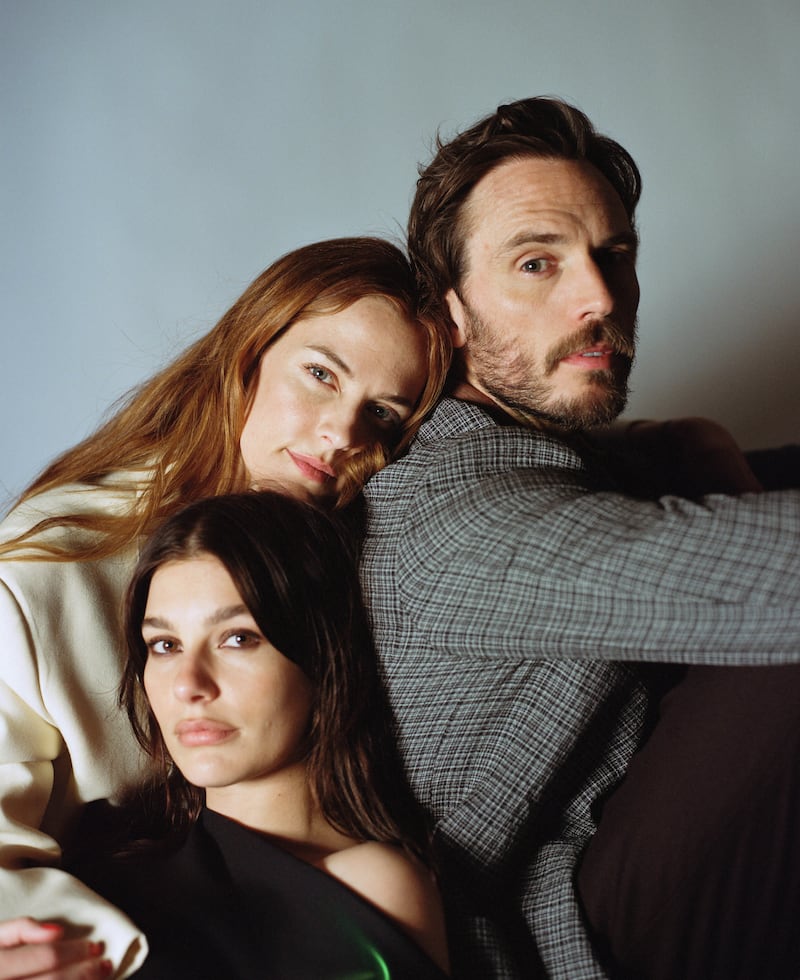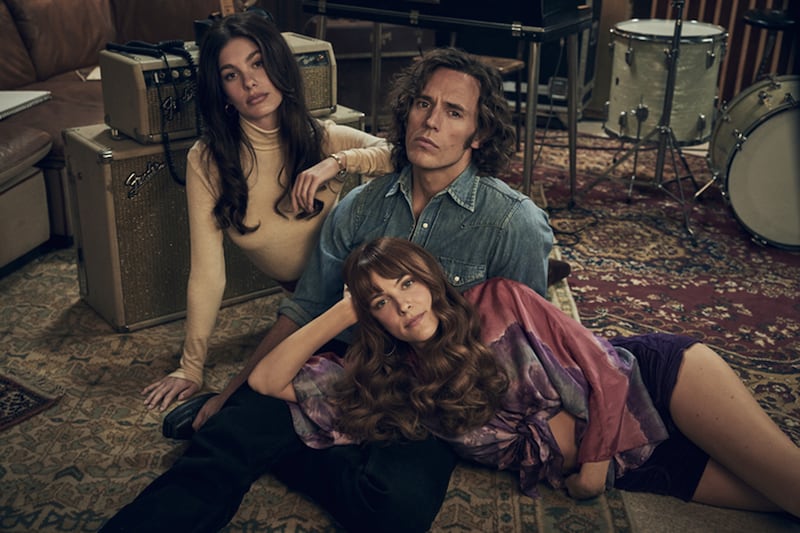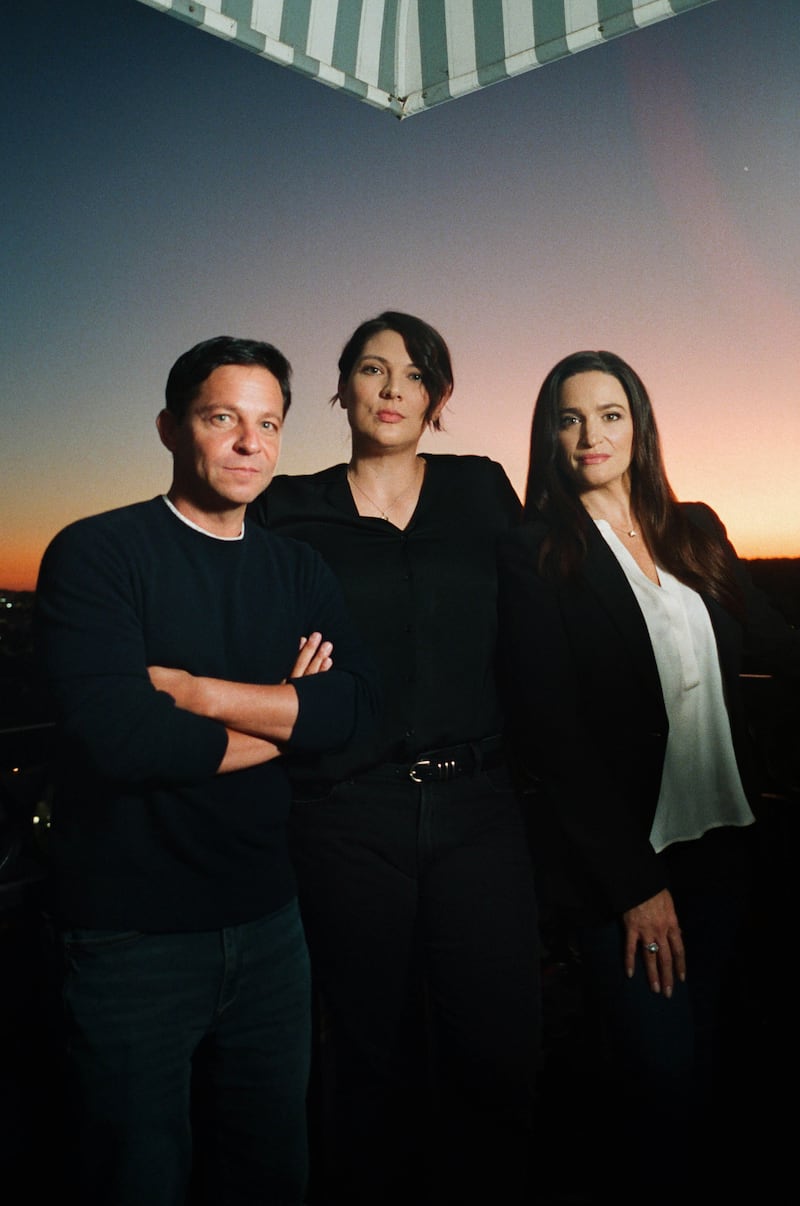It was the 36th day of what was supposed to be a 30-day shoot in New Orleans, but the cast and crew of the rock drama Daisy Jones & the Six were still at it.
They were filming a scene, set in 1977, in which the actors Riley Keough and Sam Claflin, as the lead singers of the band Daisy Jones & the Six, unwind backstage after performing on Saturday Night Live for the first time. Half-empty liquor bottles, wood panelling, smoke-machine haze and framed photos of the Coneheads and Gilda Radner surround them.
Claflin, who plays Billy Dunne, asks Keough, in the title role of Daisy Jones: “How’d it feel?”
“It felt good, yeah,” she says, “I mean, not as good as cocaine.”
READ MORE
Before New Orleans, the cast and crew had filmed for 69 days in the Los Angeles area, and afterward some of them headed to Athens and the Greek island of Hydra for a key episode. Production on Daisy Jones & the Six was initially scheduled to begin in April 2020, and even after it was postponed because of Covid-19 for about 18 months, it had to be suspended a few more times. Despite daily testing protocols and mask mandates, the reality of filming concerts with hundreds of extras, hookup scenes and booze-and-Quaalude-fuelled bacchanals had taken a toll.
“Sex, drugs and rock’n’roll is hard to do in a pandemic,” said Lauren Neustadter, who with Reese Witherspoon executive-produced the series.
The 1970s-era sets are designed to shag-carpeted verisimilitude. The production took over the Sunset Strip in Hollywood, using vintage pornography as a visual reference when they transformed the Viper Room into the seedy Filthy McNasty’s
Daisy Jones & the Six tells the story of a band’s rise to sold-out-stadium-level fame thanks to a hit album, Aurora. The musicians make and promote Aurora as Daisy, Billy and his wife, Camila Dunne (Camila Morrone), try to navigate the sharp edges of a love triangle.
It’s based on a 2019 novel of the same name by Taylor Jenkins Reid that has sold more than a million ebook and print copies, and has been translated into more than 30 languages. Part of its appeal is the storytelling approach: Reid creates an oral history that reads like nonfiction, populating it with musicians and record producers who reminisce against the backdrop of beater vans, tour buses and Sunset Strip stages.
To answer many Google searches: The Six is not a real band, although it’s inspired by Fleetwood Mac and others. Still, that uncertainty – as well as the will-they-or-won’t-they tension between Keough’s and Claflin’s characters – is something Witherspoon’s production company, Hello Sunshine, and Amazon Studios hope will grip viewers when Daisy Jones & the Six begins streaming its 10 episodes on Amazon Prime Video, starting on Friday, March 3rd.
The built-in fan base that the book provides will be a boon for the series but also brings its own anxieties. “There is for me a desire to make the fans happy and bring to life this book that has lived in their hearts and in all of our hearts for so long,” Morrone said. “I don’t think I’ve ever done a project that has this many eyes on it.”
It is one of the first projects that the head of Amazon Studios, Jennifer Salke, ordered after Jeff Bezos hired her in 2018. “You have to make noise,” she said, discussing her early days at the company and her reaction to the Daisy Jones pitch. “You have to be able to do something that is different. It can’t feel like a show that you could just get everywhere.”

Daisy Jones promised to deliver that, she said, and Amazon stood by the production as it waited out the restrictions of the pandemic.
Covid delays provided a significant benefit: more than a year for the actors to take music lessons. Before then, the most noteworthy musical credential any of them had was that Keough is Elvis Presley’s granddaughter.
If streaming-television economics are under pressure, as layoffs at Disney, Netflix and other companies indicate, you would not know it from Amazon’s investment in Daisy Jones & the Six.
The 1970s-era sets are designed to shag-carpeted verisimilitude. For a week, the production took over the Sunset Strip in Hollywood, using vintage pornography as a visual reference when they transformed the Viper Room into the seedy Filthy McNasty’s. The principal characters alone required 1,500 wardrobe changes in the first half of production. With other characters and extras, the production sometimes needed 250 outfits a night.
About 25 original songs have been written by Blake Mills, who wrote some in collaboration with others, including Phoebe Bridgers, Marcus Mumford and Chris Weisman. Eleven of those songs make up Aurora, which Atlantic Records will release when the series begins streaming. The first track, Regret Me, dropped this month and by mid-February had garnered about two million streams on Spotify.

Even the show’s public relations efforts hark back to the era of big-studio budgets: More than 30 publicists were involved (or hoped to be involved) in the reporting, photographing and fact-checking of this article. The photo shoot drew multiple entourages.
But the TV version of Daisy Jones started small, with a wife and husband in Los Angeles.
The husband is Scott Neustadter, a screenwriter whose credits include the 2009 movie 500 Days of Summer, which he wrote with Michael H Weber.
One day in 2017, Neustadter’s representatives got a call from Brad Mendelsohn, Reid’s manager, asking if the screenwriter might want to take a look at a manuscript about a fictional 1970s rock band whose trajectory and interpersonal drama resembled Fleetwood Mac’s. Neustadter, a fan of that era’s music, started reading it that morning.
He got in touch later that day with his wife, Lauren, who had just been hired by Witherspoon to lead Hello Sunshine’s film and TV division. He reminded her that he and Witherspoon had once talked about being captivated by Stevie Nicks. “I knew this was a passion of Reese’s,” he said.
Lauren spent a few hours reading Reid’s manuscript. Then she interrupted her boss’s vacation. “I need you to bring your iPad to the beach tomorrow morning,” she remembered e-mailing Witherspoon, “because this book is so good, and it’s going to be so competitive.”
The next morning, she said, Witherspoon replied: “I’m obsessed.”
Days later, the Neustadters hatched a plan.

Lauren took Reid to breakfast at Hugo’s, in the San Fernando Valley. As she was praising the book, her phone rang.
“I think this is for you,” Neustadter said, handing it to Reid, who by then had achieved modest success as an author. She maintained her chill, at least on the outside, as she listened to Witherspoon tell her how much she loved her book.
That afternoon, Scott took Reid to lunch at a coffee shop on Larchmont Avenue. “I told her I have prepared my whole life to write this,” meaning a film or TV version of Daisy Jones, he said.
Reid decided she wanted Hello Sunshine to spearhead the screen version, with Scott and his writing partner Weber attached as creators. She ultimately sold the Daisy Jones manuscript to Penguin Random House.
At the friends-and-family concert, “I was shocked,” Wright said. “They sounded like a real band. It was incredible
— Tom Wright
The work of transforming actors pretending to be in a band into a band became the professional preoccupation of music supervisor Frankie Pine. She oversaw a months-long “band camp” consisting of one-on-one instruction and group rehearsal, in addition to taking and reviewing video footage of practice sessions so they could listen to their pitch and timing and watch their comportment.
As the production prepared to start shooting in Los Angeles in September 2021, Lauren Neustadter felt it was important for the band to put on a live concert, performing songs from the show. They rented a Hollywood studio with a stage and, still limited by Covid, invited about 40 people who were working on the series.
In attendance was Tom Wright, a veteran actor (Tales From the Hood, Sunshine State) who plays Teddy Price, a Berry Gordy-Quincy Jones-esque record producer. He was prepared to be underwhelmed.
As a young actor, Wright lived in New York in the 1970s and had a roommate in the music business. “I got to know and hang out with people like Ornette Coleman and Chet Baker and Jim Hall – you know, some great jazz musicians. And I got to see them perform live, so I kind of have a high bar,” he said.
At the friends-and-family concert, “I was shocked,” Wright said. “They sounded like a real band. It was incredible.”
For Reid, who imagined this story and took it from her head to paper starting in 2016, it’s hard to believe it’s all happening. “If your book is like your baby,” she said, “then the adaptation is like my grandchild. I don’t really get to take credit, but boy, am I so proud of them.”
She is thrilled by the show, she said. “When I think of Daisy now, I see Riley’s face. When I think of Billy, I think of Sam.” – This article originally appeared in The New York Times
2023 The New York Times Company



















